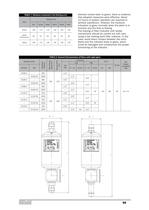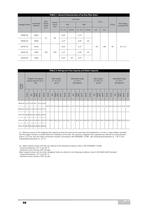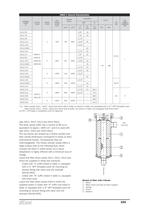
Catalog excerpts

84 In molecular sieve driers, with a charge constituted by non-agglomerated products, the dehydrating mass is pressed in between two fine steel mesh disks, or two filtering disks of various material, kept in place by a spring. In solid core driers, dehydrating and deacidifying products with binders constitute the block. Water adsorption combines with the neutralization of acids that may be present in the refrigerant, and with a strong filtering action. Castel have planned either its production lines of hermetic driers on this second solution that avoid any risk of abrasion of the charge and...
Open the catalog to page 2
85 activated alumina, and a special binding agent in appropriate proportions. The choice of blend, molecular sieves – activated alumina, gives to the block a very high capacity of acid adsorption also maintaining very good dehydrating characteristics. The presence of a controlled and defined percentage of activated alumina, lower than the maximum value recommended by ASERCOM, keeps unchanged the original concentration of additives in the polyolester lubricant. The blocks in the filters series 43 are molded from a blend of dehydrating charge, totally made of 3 Å molecular sieves, and a...
Open the catalog to page 3
86 Solid core dehydrator 1 – Spring 2 – Block 3 – Felt 4 – Stainless steel mesh maintaining quite good deacidifying characteristics. The manufacturing process gives a considerable compacted ness and stoutness to both the products so that they are resistant to shocks and abrasions. The shape of the block is designed in order to offer the maximum possible surface area to the incoming fluid. The internal cavity is also positioned in such a way as to have a uniform wall thickness. As a result, the fluid encounters a constant strength at all points, flows linearly through the block, and ensures...
Open the catalog to page 4
94 APPLICATIONS The filters, shown in this chapter, are classified “Pressure vessels” in the sense of the Pressure Equipment Directive 94/23/EC, Article 1, Section 2.1.1 and are subject of Article 3, Section 1.1 of the same Directive. They are designed for installation on commercial refrigerating systems and on civil and industrial conditioning plants, which use refrigerant fluids proper to the Group II (as defined in Article 9, Section 2.2 of Directive 97/23/EC and referred to in Directive 67/548/EEC). Filters series 41 have been developed for specific installations on refrigerating...
Open the catalog to page 12
95 TABLE 1: Moisture contained in the fluid [p.p.m.] Colour Refrigerant fluid R22 R134a R404A R407C R410A R507 Green <60 <75 <30 <30 <30 <30 Green Chartreuse” 60 75 30 30 30 30 Yellow >60 >75 >30 >30 >30 >30 TABLE 2: General Characteristics of filters with sight glass Catalogue Number International Reference Block Filtering Surface [cm2] Nominal Volume [cm3] Connections TS [°C] PS [bar] Risk Category according to PED SAE Flare ODS ODM SAE Flare ODS Ø [in.] Ø [mm] Ø [in.] Ø [mm] min. max. 4108/2 – 082 103 130 1/4” – – 40 80 45 Art. 3.3 – 4108/2S 082S – 1/4” – 3/8” – 4108/3 – 083 3/8” – –...
Open the catalog to page 13
97 APPLICATIONS The filters, shown in this chapter, are classified “Pressure vessels” in the sense of the Pressure Equipment Directive 94/23/EC, Article 1, Section 2.1.1 and are subject of Article 3, Section 1.1 of the same Directive. They are designed for installation in liquid lines on conditioning plants with reverse-cycle, on heat pumps and on refrigerating systems which use refrigerant fluids proper to the Group II (as defined in Article 9, Section 2.2 of Directive 97/23/EC and referred to in Directive 67/548/ EEC). Filters series 46 have been developed for specific installations on...
Open the catalog to page 15
98 TABLE 1: General Characteristics of by-flow filter driers Catalogue Number International Reference Block Filtering Surface [cm2] Nominal Volume [cm3] Connections TS [°C] PS [bar] Risk Category according to PED ODS ODM Ø [in.] Ø [mm] Ø [in.] Ø [mm] min. max. 4608/3S 083S 70 95 3/8" – 1/2" – – 40 +80 45 Art. 3,3 4608/4S 084S 1/2" – 5/8" 16 4616/3S 163S 105 150 3/8" – 1/2" – 4616/4S 164S 1/2" – 5/8" 16 4616/5S 165S 5/8" 16 3/4" – TABLE 2: Refrigerant Flow Capacity and Water Capacity Catalogue Number Refrigerant Flow Capacity, pressure drop 0,07 bar (1) [kW] Water Capacity at + 25 °C (2) [g...
Open the catalog to page 16
100 using the old CFC or HCFC refrigerant fluids, mixed with mineral lubricants. The blocks 4490, type A and type B, and the block 4491, type A, are molded from a blend of dehydrating charge, totally made of 3 Å molecular sieves, and a special binding agent in appropriate proportions. The choice of the 3 Å molecular sieves, as sole dehydrating material, gives to the block a superlative capacity of water adsorption also maintaining quite good deacidifying characteristics. The blocks 4490, type AA and type AB, and the block 4491, type AA, are molded from a blend of dehydrating charge, 80% of...
Open the catalog to page 18
101 type 4411, 4412, 4413 and 4414 filters. The block series 4491 has a volume of 96 cu.in., equivalent to approx. 1600 cm3. and it is used with type 4421, 4423 and 4424 filters. The two blocks are shaped as a hollow cylinder and their overall dimensions correspond to those of other international brands. Consequently they are interchangeable. The hollow cylinder shape offers a large surface area to the inflowing fluid, which crosses the block in radial sense. As a result, dehydration is highly efficient with a minimum loss of charge. Liquid line filter driers series 4411, 4412, 4413 and...
Open the catalog to page 19
104 Blocks must be ordered separately from the filter. They are supplied in individual packages, which are hermetically sealed in suitable wrappings (type 4490), and in special bags (type 4491) for safe storage over long periods of time. Every cartridge is equipped of two seals in synthetic material to use like seal between the two cartridges and between the cartridge and its covers. If the filter is installed in a system without any by-pass, the block replacement has to be done following these instructions: 1 Close the valve on the departing line. 2 Start the compressor and its auxiliaries...
Open the catalog to page 22All CASTEL catalogs and technical brochures
-
CASTEL - 2013 General Catalogue
105 Pages
-
VALVES FOR REFRIGERATING SYSTEMS
34 Pages
-
REFRIGERATING SYSTEMS PROTECTORS
38 Pages
-
OIL CONTROL SYSTEM
22 Pages
-
PRODUCTS FOR CO2 SYSTEMS
7 Pages
-
Products catalogue
101 Pages
Archived catalogs
-
Products Catalogue 2008
84 Pages
-
Threaded brass fittings
10 Pages
-
Valves
20 Pages
-
Oil separators
6 Pages
-
Water regulating valves
6 Pages
-
Check valves
6 Pages
-
Safety devices
16 Pages
-
Solenoid valves
18 Pages
-
Expansion valves
16 Pages

























